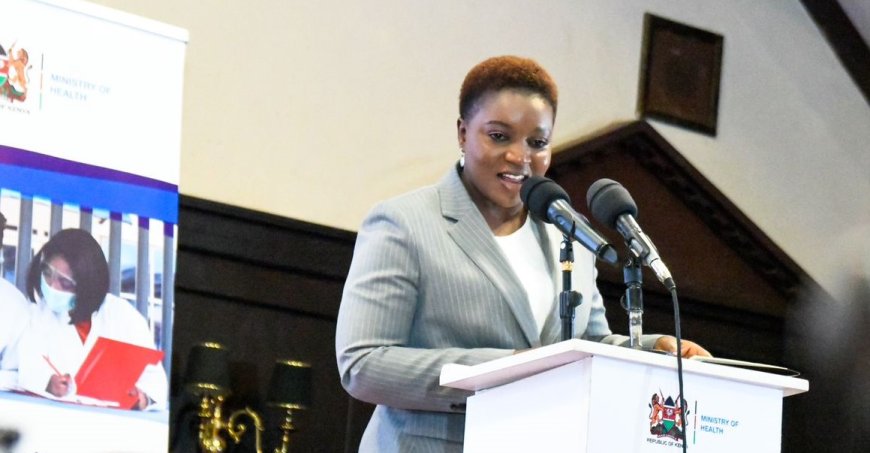Government to find lasting solutions for health workforce challenges

Kiambu,
Thursday, October 12, 2023
KNA by Wangari Ndirangu
Health workers are facing major challenges in the execution of their mandates at both national and county levels, Health Cabinet Secretary Susan Nakhumicha has said.
The challenges she noted are diverse, ranging from training and development, staff welfare and progression, performance management and motivation, health worker safety and welfare, and staff mobility, including transfer across counties and levels of government.
Despite all these, the CS added that health workers continue dedicating themselves to the service of Kenyans and the onus should be on collective effort to identify the most pragmatic solutions to these challenges and this can only be achieved through constant dialogue.
The CS who was speaking today during the official opening of the Pre-National Human Resources for Health (HRH) Dialogue meeting geared towards improving, developing and managing the healthcare workforce, said a strong healthcare system results in a healthier population, which forms the basis of a productive workforce and a strong economy.
Nakhumicha acknowledged that although the country does not have a shortage of institutions and policies for guiding and supporting the human resources for health function in the health system, the government has recognized risks posed by the absence of a central coordinating mechanism for policies and strategies touching on various facets of human resource for health.
“The Government is committed to finding lasting solutions to the health workforce challenges that have plagued the health sector for decades. It is for this reason that the National and County Governments came together to constitute the Kenya Health Human Resource Advisory Council (KHHRAC) whose governing council had never been constituted leaving a gap in coordination of HRH-related matters.
The CS said they are working towards improving other pillars of the health system, including health products and technologies, health information and healthcare financing to support effective service delivery.
“We have four crucial Draft Bills in parliament as we speak, specifically developed to accelerate attainment of universal health coverage. These are the Social Health Insurance Bill (2023), the Primary Healthcare Bill (2023), and Facility Improvement Financing Bill (2023) and the Digital Health Bill (2023),” she said.
Kenya, she confirmed is one of the first country in the region to effectively roll out the National Health Workforce Accounts that is a WHO-supported system designed to help countries progressively improve the accuracy, quality and utilization of health workforce data, and measure effectiveness of interventions deployed to improve development and management of human resources.
“I am happy to announce that we now have a clearer understanding of crucial health workforce data, including employment, retention and attrition”, she said.
The government, she noted, recently adopted the Workload Indicators of staffing needs approach that will help in not only determining health facility staffing based on workload, but also estimate stress levels.
“The latter is particularly important for health worker wellbeing. We want to protect our health workers from excessive strain, which is a risk factor for medical error and mental illness,” she said as she assured health workers that they will soon know with fairly good accuracy, where there are severe shortages, allowing them to rationalize distribution and plan for recruitment where gaps remain.
Nakhumicha noted that while developing policies is important for effective service delivery, all must not lose sight of the importance of ensuring complete execution, backed by reliable systems of consistently gathering information on the health workforce.
Principal Secretary, State Department for Public Health and Professional Standards, Mary Muriuki said that currently in the country, the density of doctors, nurses, and clinical officers stands at 30.14 per 10,000 individuals, which is below the Sustainable Development Goals (SDG) index threshold of 44.5.
“Kenya has an estimated population of 200,000 healthcare providers and out of this 66 percent are employed in the public sector, while the remaining 34 percent work in the private sector. Among these professionals, nurses comprise the largest group, accounting for 58 percent of the entire healthcare workforce, clinical officers 13 percent, and doctors represent 7 percent.
Unfortunately, Muriuki noted that healthcare providers are predominantly concentrated in urban areas, leading to a significant rural-urban disparity in access to medical services and healthcare professionals in Kenya and this discrepancy poses a substantial challenge in providing equitable healthcare across the country.
On the upcoming Mashujaa Day event, the PS said that the President will launch Universal Health Coverage centered on four pillars and one of them will be Human Resource for Health (HRH) which is a critical pillar that underscores its central role within this comprehensive healthcare framework and the achieving of the Bottom-up Economic Transformation Agenda for health.
The two day Pre-National Dialogue is a crucial preparatory step for the National dialogue on Human Resources for Health that is planned for next week, 18th October, in Kericho.
Courtesy; KNA
What's Your Reaction?
































































































































































































































































































